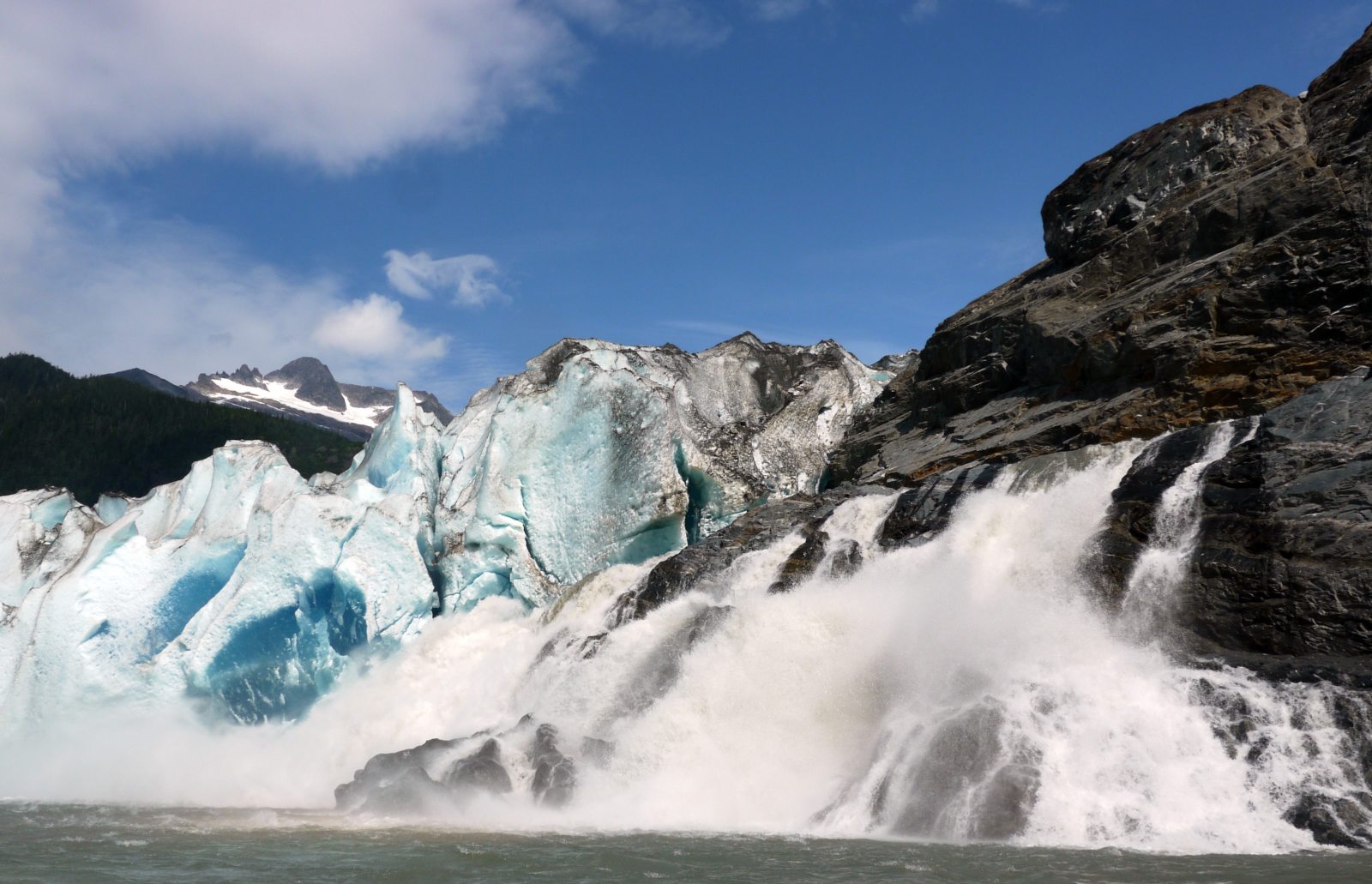Melting glaciers: The great ocean fertilizers
 Organic grit from human activities — preserved by glaciers for centuries and now flushing into the ocean in a colossal regional meltdown — may be fueling the marine food web of the Gulf of Alaska and other coastal ecosystems in unprecedented ways, according to a new study published online this week by Nature Geoscience.
Organic grit from human activities — preserved by glaciers for centuries and now flushing into the ocean in a colossal regional meltdown — may be fueling the marine food web of the Gulf of Alaska and other coastal ecosystems in unprecedented ways, according to a new study published online this week by Nature Geoscience.
A team of scientists found that the major source of the carbon spewing off Alaska’s glaciers into the sea isn’t ancient peat or long-buried forests, as once assumed.
Rather, it’s the dissolved fall-out from the burning of fossil fuel by people from across the globe over many centuries.
“Remote regions are often perceived as being pristine and devoid of human influence,” said lead scientist Aron Stubbins from the Skidaway Institute of Oceanography in Georgia, in this story about the research. “Glaciers show us that nowhere goes untouched by industry. Instead, burning fuels has an impact upon the natural functioning of ecosystems far removed from industrial activity.”
The study, which married ice-stomping field science to molecular spectrometry, may challenge assumptions about what factors truly influence Alaska’s rich marine ecology and bolster the health of its multibillion-dollar fisheries.
With glacier melt accelerating due to climate warming, and most tidewater glaciers locked into a retreating phase, the amount of dissolved organic material that’s flushing into coastal waters has soared in recent decades.
As a result, the microbes and plankton at the bottom of the food web in marine ecosystems like the Gulf of Alaska have basically been guests at an extraordinary banquet of organic nutrients. It means, the scientists said, that this vast dump of glacial carbon into coastal waters is a development of modern times.
Which raises a jarring question. Is Alaska’s marine environment so productive because it’s fertilized by human-generated soot, or because it’s a pure enclave in a polluted world?
“When we look at the marine food webs today, we may be seeing a picture that is significantly different from what existed before the late-18th century,” Stubbins said in a different story posted by the National Science Foundation. “It is unknown how this manmade carbon has influenced the coastal food webs of Alaska and the fisheries they support.”
Sampling glaciers for soot secrets
The paper — “Anthropogenic aerosols as a source of ancient dissolved organic matter in glaciers” — arose from a NSF-sponsored project that examined glaciers and their runoff in Alaska and other locales. The bulk of the samples came from Mendenhall Glacier near Juneau. The study’s 13 co-authors represent institutions in eight states, and include Eran Hood and Andrew Vermilyea from the University of Alaska Southeast.
Dissolved organic matter flushing out of glaciers has long been recognized as a major source of “ancient, yet highly bio-available carbon to downstream ecosystems” like rivers, estuaries and the ocean, the scientists explained in the paper.
The stuff enriches every drop of glacial outflow with nutrients, and all of it ultimately gets consumed by microorganisms and other tiny critters at the bottom of the aquatic food chain.
But where does all that digestible carbon come from?
“The remnants of ancient peatlands and forests overrun by glaciers have been invoked as the source of this organic matter,” the scientists wrote. “Here, we examine the radiocarbon age and chemical composition of dissolved organic matter in snow, glacier surface water, ice and glacier outflow samples from Alaska to determine the origin.”
In 2009 and 2010, the scientists visited the Mendenall Glacier to take 11 samples. They also sampled Herbert Glacier outflow, about five miles north of Mendenhall Glacier, and Peterson Creek, which isn’t fed by glaciers.
“The Gulf of Alaska (GOA) drainage basin contains more than (29,000 square miles) or (about 10 percent) of the mountain glaciers on Earth and the annual runoff from this region represents the second largest discharge of freshwater to the Pacific Ocean,” they explained in a supplemental article about their methods. “Rates of volume loss from glaciers in this region are among the highest measured on earth and have increased substantially in the last decade.”
While the water in the creek was laced with bits and gunk from the surrounding rain forest, the glacial sources yielded organic material that didn’t come from any Alaskan landscape.
For one thing, the glacial samples were depleted of the radioactive carbon that would be present in higher concentrations if it were full of the plant litter and peat ground into oblivion by the glacier, the scientists said.
Instead, the material contained gobs of protein-like compounds that originated in microbes or airborne dust known as aerosols, discovered using a process called fluorescence spectrophotometry. They also analyzed the stuff with ultrahigh-resolution mass spectrometry and made another find — combustion products that come from the burning of fossil fuels and forests.
“Based on the presence of these compounds, we suggest that aerosols derived from fossil fuel burning are a source of pre-aged organic matter to glacier surfaces,” they concluded. “Furthermore, we show that the molecular signature of the organic matter is conserved in snow, glacier water and outflow, suggesting that the anthropogenic carbon is exported relatively unchanged in glacier outflows.”
No place untouched by humans
Among other insights, the results demonstrate that human activities influence the ecology of every place on Earth, including the nutrient content and organic material buried in the Juneau Icefield.
“We are finding this human derived signature in a corner of the U.S. that is traditionally viewed as being exceptionally pristine,” said co-author Robert Spencer, of the Woods Hole Research Center, in a story about the research. “The burning of biomass and fossil fuels has an impact we can witness in these glacier systems although they are distant from industrial centers, and it highlights that the surface biogeochemical cycles of today are universally post-industrial in a way we do not fully appreciate.”
Any black soot or aerosol dust that falls on the glacier in rain or snow gets locked up inside the ice and preserved, the scientists said. It travels with the glacier until it melts out, perhaps centuries later, and then feeds into the environment with its organic contents undegraded. In contrast, the same organic material falling on forest or grassland would be quickly consumed.
“In frigid glacier environments any input stands out, making glaciers ideal sentinel ecosystems,” Spencer said.
As the climate warms, the disintegration of Alaska’s coastal glaciers may accelerate and deliver ever more dissolved organic material into the ocean off Alaska’s coast. Waters off Greenland and Patagonia, with their own big meltdowns underway, will see similar increases.
How will Alaska marine life fare as this process goes on?
“It’s not known to what extent organic material deposition has changed, and will continue to alter, glacially-dominated coastal ecosystems,” Stubbins said here.
Contact Doug O’Harra at doug(at)alaskadispatch.com
For more stories from Alaska Dispatch, click here.



